Skywatcher Skymax 180 Pro Maksutov
The Planet-Killers
The term, “planet-killer” is bandied about quite a lot these days, along with references to “planetary ‘scopes”. Supposedly, some designs of telescope are more suited to being “planet-killers” than others – traditionally, refractors of 4-inch aperture or more have been thought of as planetary ‘scopes, more so than reflectors or Schmidt Cassegrains. So, what is required of a planetary ‘scope that others don’t deliver? And why am I asking this in the introduction to a review of my latest ‘scope: the Skywatcher Skymax 180 Pro Maksutov? Will the questions ever end?
Over the first quarter of 2010 I had been absorbed by the views offered by Mars. Viewing the planet in my 8” Dobsonian and my 120mm APO yielded some of the most detailed views of the planet I’ve ever seen. The Dobsonian naturally revealed slightly more detail, and was capable of doing so at magnifications of up to 230x. Higher than that and the planet drifted across the field of view more rapidly than was comfortable for detailed observation. The equatorially mounted Equinox ED120 yielded fabulous views too, up to (and even exceeding) the same sort of magnification levels, but the difference in aperture was noticeable in the amount of detail resolved. The built-in motorised tracking made up for this to some extent. Mars was so high in the sky those months that it was free from the annoying turbulence near the horizon, and was therefore capable of being viewed at these fairly high powers with little trouble from atmospheric disturbance.
I began to think, wouldn’t it be great to have a ‘big’ scope capable of revealing as much detail as the Dob, mounted on my driven equatorial mount, to combine the best of both worlds: aperture and motorised tracking. And then, suddenly, a 180mm f15 Skymax 180 Pro Maksutov became available at a ridiculously low price and the object of my desires was within my grasp! A telescope with 7.1 inch diameter, a small secondary obstruction, long focal length (2700mm), high focal ratio (f15) and reportedly good quality optics.
Before I get to reviewing the telescope itself, I’ll share my list of ‘needs’ from a planetary telescope:
- Enough aperture to resolve serious planetary detail
- Ability to employ high magnifications comfortably
- Capacity to be mounted on my equatorially driven mount
- Freedom from chromatic aberration (false colour) and other aberrations that would detract from the view.
A Killer Deal
I don’t normally share the prices of my second-hand kit with people, but in this case I will do so, hopefully to inspire and show what is available to the keen shopper if they are willing to look around and be patient. Knowing the sort of thing I was looking for, I started visiting the astronomy classified site www.astrobuysell.com/uk and got into the habit of sitting refreshing the screen every few seconds. After only a few hours, an advert for a Skymax Pro 180mm Maksutov with all original accessories (finderscope, two eyepieces, diagonal) and packaging, along with a home made dew strip and controller, all in good used condition, appeared. I was the first person to view the advert and by the time a second person saw it, I’d bought it. The price was £300.
Upon arrival, I was impressed by the size and weight of the ‘scope. It is heavy but squat, weighing in at about 20lb and with a diameter of 216mm and length of 50cm. It has a 1.25” visual back, which limits it to using 1.25” diagonals, eyepieces and accessories. More on that later. The accessories were all in good condition (finderscope and eyepieces sold later on to help reduce overall price) and the dew-strip seemed fine with good quality cabling and a nice nifty four-setting controller that has a 12v cigarette-lighter plug attached.
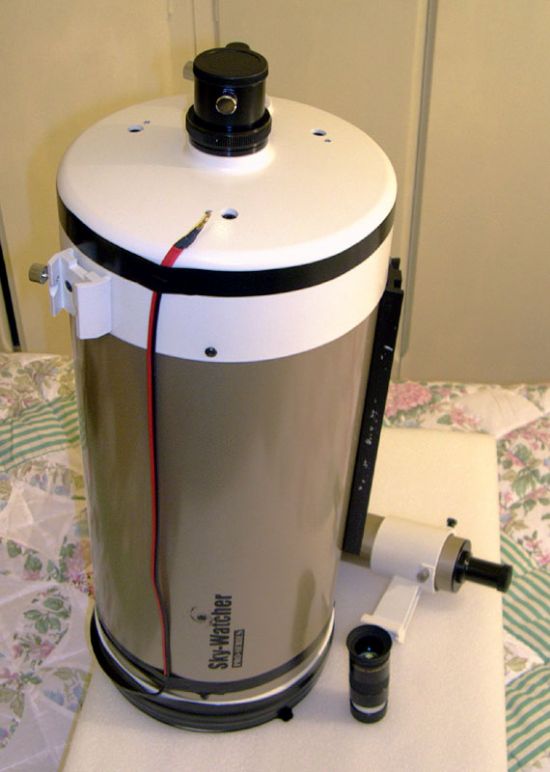 |
| It's big. That's a 32mm Plossl beside it for scale. |
Sticking it on the Vixen GP mount showed that the mount would be capable of managing the weight, but both counterweights I own were needed to balance the mount effectively. Oh, the front objective or corrector plate was in very good but not perfect condition, which is fine, and it showed that the telescope had been used but cared for. The primary mirror only had very minor levels of dust on it, which was also perfectly acceptable. The tube is attached to the mount by means of a dovetail bar bolted into the tube wall. Though the tube wall itself is about 4mm thick, I had concerns about the strength of such a mounting system and was keeping half an eye open for mounting rings of a suitable size.
Mechanical Details
Some items of note that you may be interested in before we get to the optics. First, it is possible to attach an adapter ring to the rear of the scope to allow attachment of 2-inch accessories. By employing such a device you can then fit a third party Crayford focuser for fine focusing at higher powers, or to get pinpoint focus for imaging. The adapter ring also enables one to use a 2-inch diagonal (via an SCT-thread to 2” push-fit accessory adapter) and therefore 2-inch diameter eyepieces. This would allow wider fields of view to be achieved. However, although a wider field of view may be seen, it might not be as good as you might expect.
The light path onto the focal plane passes through a narrow outlet, only about an inch in diameter. This is fine for 1.25” eyepieces, as the view across the field is uniformly illuminated. That is, the light from the light cone spreads across the entire visual field of view uniformly, giving a view which is the same brightness all the way across. When a 2-inch diameter eyepiece is employed, the light cone does not extend out far enough to cover the entire (wider) field of a 2-inch eyepiece uniformly, so the outer edge of the field of view may appear slightly darker than the middle area. This did not bother me, as I wanted to use the ‘scope for planetary viewing, which would not require wide fields of view anyway.
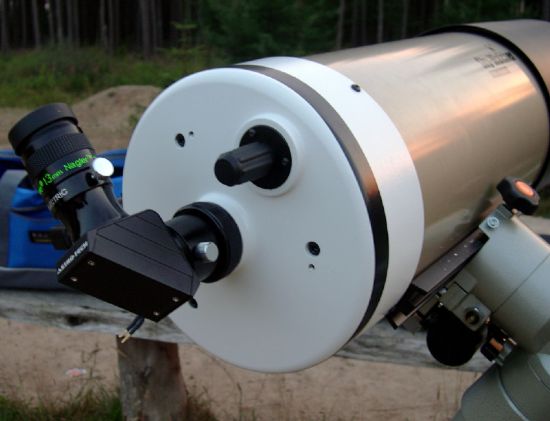 |
| The simple yet effective focuser at the touchy-feely end. |
Another ‘issue’ is the way in which focus is adjusted in Maksutovs. The focus knob moves the primary mirror back and forth, which increases or decreases the distance between it and the secondary reflector meniscus on the inside of the corrector plate, and thus changes the effective focal length of the telescope. This interacts with the different eyepieces being used, and moves the focal plane in or out correspondingly. This focus mechanism results in two interesting points. First, the focal length of the telescope changes depending on what eyepiece you are using and where the focal plane rests. Ultimately, this means that the differing focal length of the ‘scope makes it slightly inaccurate to use the standard formula for working out the magnification given by an eyepiece (magnification = focal length of ‘scope divided by focal length of eyepiece). If you use the specified focal length (2700mm in the case of the 180 Pro) the magnification calculated may not be exactly the same as it gives in practice, though the difference will only be very small.
Second, the mirror will experience some ‘flop’ which may show itself at higher magnifications as a slight amount of ‘image shift’, as the pressure is not exerted on the primary in the centre, but at one side of it. Image shift is noticeable when reversing focus direction, as a slight lateral movement of the image within the field of view. This is one of the reasons that Maksutov owners like to mount third-party Crayfords or other additional fine-focus mechanisms on their ‘scopes, to eliminate or reduce the effect.
Without even trying the ‘scope under the sky, I mounted a Borg helical fine-focuser (model number 7315) on the rear port of the telescope. However, it was not heavy duty enough to handle the lateral weight of a diagonal and an eyepiece, and so was not as smooth as I thought it would be. Without any load inserted in it the Borg helical focuser was buttery smooth and light to use, but sadly I intended to use it with diagonal and eyepiece, so back it went. Initial testing of the Mak would be with its standard focusing mechanism only.
First Light
Amazingly, First Light took place at one of the HAS members’ night observing sessions, on a cold but mostly clear March night. Although there were a variety of other ‘scopes set up, I was perhaps understandably obsessed with my own particular one that night. I set it up on the Vixen GP, balanced it, polar-aligned it (quite important to do this very accurately for a long focal length ‘scope like this) and set about choosing some targets.
First object was the Moon. At 5 days old Mare Serenitatis was just beginning to open up, and crater Theophilus showed some nice high-contrast features around its rim. I started off with a 22mm Vixen LVW for 122x and was rewarded a stunning view of the entire sunlit portion of the Moon, with a sharp view across the entire field of view. Note, yes – 122x with a 22mm eyepiece! Even a traditionally ‘medium power’ eyepiece in the 20-odd mm focal length range is going to give a higher than usual magnification in a ‘scope with a focal length of nearly 3 metres!
Increasing power with 16mm (168x) and 13mm (207x) Naglers simply improved the view. More magnification gave more detail, sharper edges, and stark black/white contrast: put simply, bigger, better, more - except the field of view. In an f15 ‘scope you’re never going to get an exactly panoramic view, and even the 82-degree Naglers gave views that were narrower than I was used to in my other ‘scopes. Not that this was a bad thing: after all, I wanted to study small objects in fine detail, so why bother with all that extra space anyway?
Mars was splendid that night too, and I was able to use 385x with a 7mm Orthoscopic to reveal several dark land features and both polar caps. The image was still small, even at that power, but then Mars was getting quite distant again at that time. At this point in the evening, I began to realise that at least some of my planetary ‘scope ‘needs’ were already being met: the power to resolve fine detail clearly, at high power, and all atop a motorised mount. I was happy.
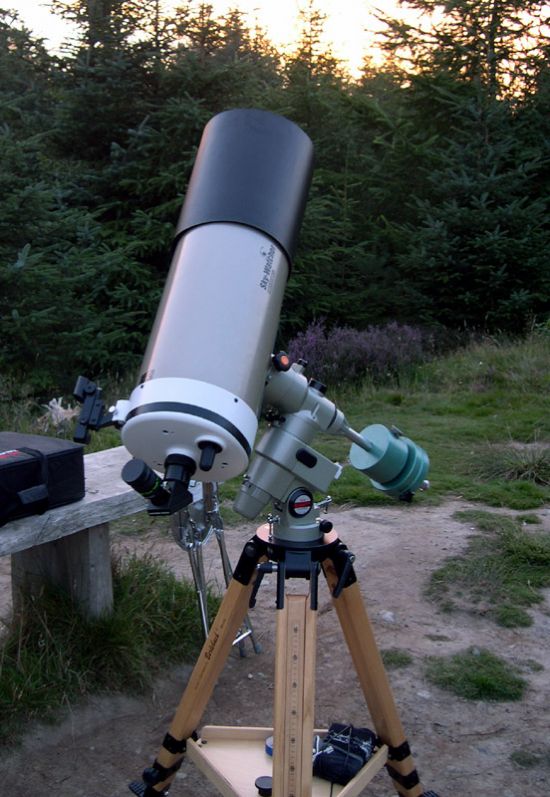 |
| Planetary observational Nirvana! |
I swung the ‘scope over to M42 to examine the Great Orion Nebula, and was impressed by the 3D effect of the nebulosity. The four main Trapezium stars were steady and sharp at 122x, but I couldn’t detect the fifth E star. Increasing the power showed that the stars were not as pinpoint sharp as in my Equinox 120 ED refractor, but that was to be expected. The refractor has no central obstruction, after all, so more of the light goes into the central ‘airy disc’ part of a focused star, hence the more pinpoint appearance. The central obstruction in a Maksutov, although small, is still sufficient to divert a little of the light into the diffraction rings, and leave the stars as a tiny bit more bloated than in an APO. Regardless of this, the view was still excellent.
Sigma Orionis, the multiple component star system below Alnilam in Orion’s belt, was exceptional, with every single component showing as a sharp, clear point, with the brighter ones exhibiting perfectly circular diffraction rings. A beautiful sight, and the extra aperture of the Mak over my Equinox helped to show the fainter components to greater effect. The rest of the night passed uneventfully, with the expected excellent views, the brief appearance of Saturn, and the inevitable clouding over that came along at about 22:30. Roll on Second Light.
Second Light
Let’s fast-forward half a year or so. Second light actually came six months later, in the early hours of a still, calm August morning. 01:30 to be exact and the reason for my early rising was Jupiter’s appearance at a decent elevation in the southern sky.
This was my first view of Jupiter using the ‘new’ ‘scope, and having found it in the eyepiece I was very impressed by the view. Even at 90x with a 30mm Plossl the disc appeared large and the Northern Equatorial Belt was easily visible, along with suggestions of other narrower belts. What really impressed me though, as I progressed through a range of magnifications, was the neutral colour tone that the ‘scope showed. The basic disc colour was pale magnolia – a much paler colour than I remembered in previous observations of the planet using other telescopes. The NEB was a soft light brown colour, as was the southern polar region, with banding within. Striation within the NEB was visible, and I could detect a hint of some spot or other to the north of it, though I know it wasn’t the Great Red Spot as that wasn’t due to transit for another few hours.
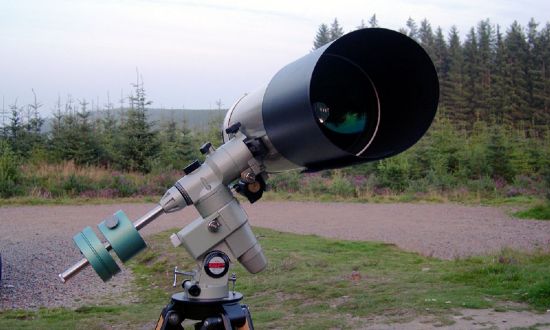 |
| It's a hefty package ... but the views are worth it! |
At this particular time, the Southern Equatorial Belt has disappeared, and I was left with the impression that the region where it was normally seen was sort of washed out or overexposed! Amazing how you can notice when something is missing, even though you haven’t actually looked for it for many months!
Having studied Jupiter (with the best views being enjoyed at 216x) I decided to have a look at M15 in the constellation Pegasus. The view was entirely as expected. Not quite as much resolution as my 8” Dobsonian gives me, but excellent contrast and brightness nonetheless. The core was definitely beginning to open up nicely at 207x and the overall view was exactly what I’d expect of M15 through a medium-sized telescope.
Deep Sky
I’ll be honest. I haven’t made as many deep sky observations through the Big Mak as I had hoped or expected. For some reason, whenever I’m out with the Mak I feel drawn to look at things like the Moon, planets, Moon, planets and of course the Moon. Oh, and the planets. What deep sky objects I have looked at have all been revealed very well, and as expected. The brighter Messier globular clusters are all nicely resolved and seem to be just on the point of “opening up” in terms of resolution. Galaxies such as M31, M51, M81 and M82 again are easily observed and show some detail within their structures, but not as much as the 8-inch Dobsonian would show. Double and multiple star systems however, show very nicely, and even open clusters give nice contrasty views, though not in the same league as my apochromatic refractors.
Conclusions
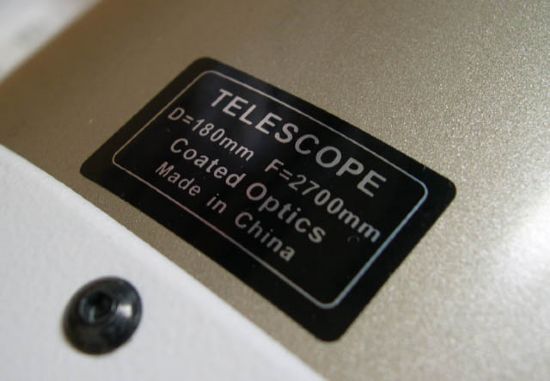 |
| Vital Statistics! |
But this is somewhat beside the point for me, as I was seeking a telescope with a very specific set of performance parameters, not another ‘general purpose’ tube assembly. As a general purpose ‘scope, the 180mm Skymax Pro MAY leave something to be desired in terms of resolution, in comparison to, for example, an 8 or 10-inch Newtonian or 5-inch refractor or 8-inch Schmidt-Cassegrain. For my purposes though, it excels at what I use it for – detailed observation of the Moon and planets on a driven equatorial mount.
For the future though, this might not be the case for others. After all, it is now possible to buy 12-inch, 10-inch and even 8-inch Dobsonians with built-in tracking, which kind of gives the humble Dobsonian Newt a valuable extra string to its bow. Will I swap the Mak for one of these new-fangled tracking Dobs?
You’ll have to wait and see.